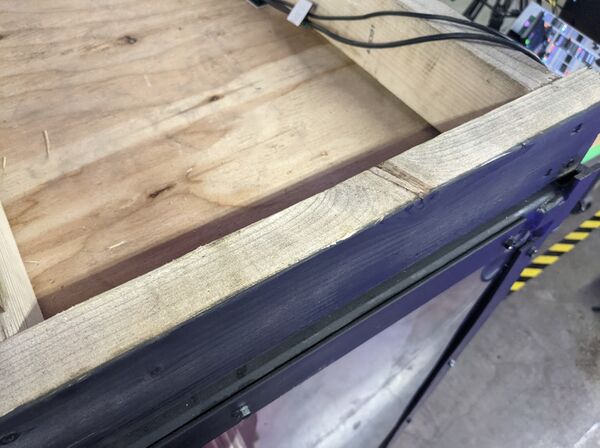Cage Design: Difference between revisions
(Created page with "All fights at NHRL happen either in one of our two 8' x 8' 3lb cages, or in our 16' x 16' 30lb cage. == 3lb cage design == center|frameless|upright 2.0...") |
mNo edit summary |
||
| Line 29: | Line 29: | ||
The floor of the cage is primarily composed of 2 sheets of ¾” plywood. The floor of the cage is not connected to the walls, to allow a gap for ventilation. The floor fully sits on 3 steel tubes that span the width of the cage. These steel tubes are held in on either side in a cradle that does not allow them to move down or to the side, but that can be lifted out when the floor is not present for easy maintenance and to get the internal lexan out. The wooden corners and wooden side skirt of the cage are connected to the floors, but the steel skirt beyond the wooden skirt is bolted to the frame. There is a less than ⅛” gap between the wooden skirt and the steel skirt. The wooden skirt is held to the floor with wood screws from the underside through the plywood, while each of the corners gets a large bolt through the top retained with a nut under the floor plywood. Pictured below is one of the corners (left), and one of the floor support tubes in its cradle (right). |
The floor of the cage is primarily composed of 2 sheets of ¾” plywood. The floor of the cage is not connected to the walls, to allow a gap for ventilation. The floor fully sits on 3 steel tubes that span the width of the cage. These steel tubes are held in on either side in a cradle that does not allow them to move down or to the side, but that can be lifted out when the floor is not present for easy maintenance and to get the internal lexan out. The wooden corners and wooden side skirt of the cage are connected to the floors, but the steel skirt beyond the wooden skirt is bolted to the frame. There is a less than ⅛” gap between the wooden skirt and the steel skirt. The wooden skirt is held to the floor with wood screws from the underside through the plywood, while each of the corners gets a large bolt through the top retained with a nut under the floor plywood. Pictured below is one of the corners (left), and one of the floor support tubes in its cradle (right). |
||
{| |
|||
| ⚫ | |||
[[File: 3lb |
| [[File: 3lb 5.jpg|frameless|upright 1.5|left]] |
||
| ⚫ | |||
|} |
|||
== Ceiling == |
== Ceiling == |
||
Revision as of 00:10, 14 June 2021
All fights at NHRL happen either in one of our two 8' x 8' 3lb cages, or in our 16' x 16' 30lb cage.
3lb cage design
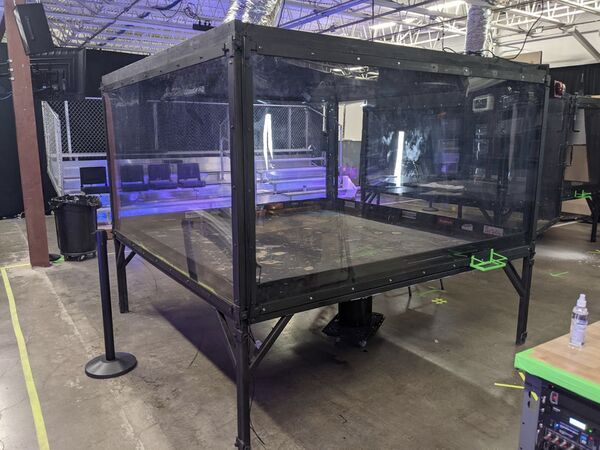
Frame
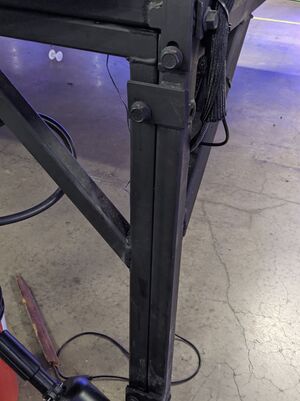
The frame of the 3lb cage is composed primarily of welded 1” tube stock. The frame is what everything else bolts to, and provides the cage with the majority of its structural integrity. Pictured to the left is the legs of the cage, which is composed of the welded steel tube.
The 4 sides of the frame are bolted together, allowing the cage to be disassembled partially to be moved. The overlapping plate and bolts for 2 sides can be seen in the picture to the left.
Lexan Walls
The 3lb cage uses 2 sheets of ¼” lexan on each of the sides, with a 1” air gap between them (defined by having a 1” tube stock between the sheets around the perimeter. The 3 non-door walls are each one full 4’ x 8’ standard sheet. The outer full sheets are held in place from the outside with steel plates that bolt into the frame. Removing these plates around the perimeter of the sheet allows it to be pulled out directly. The internal full sheets slot in between the welded internal skirt of the cage and the welded tube frame of the cage. Taking these sheets out and putting them in relies on the flexibility of the lexan.To reduce the noise of the fight, rubber is placed between the lexan and the cage’s steel. Seen below is an image of the lexan retainer along the top of the inside of the cage (left), forming a channel for the sheet to fit into. Seen below is an image of the lexan retaining plates along the outside of the cage (right).
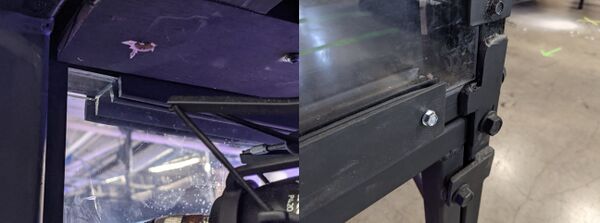
Doors
One side of the cage is taken up fully by the doors. Each door is 2 half sheets of lexan, retained similarly to the walls, wth steel tubing fully surrounding it. The tops and bottoms of the doors rest against the welded steel frame of the cage. The doors are connected to the welded steel frame on either side with 2 hinges each. The doors sit flush to each other when closed, but one door is given an additional welded steel flange that provides an overlap to cover the gap between the doors. A spring-loaded latch welded to one door latches into a catch plate welded to the top of the frame. Pictured below are the doors closed (left) with the latch and the cover plate coming from the left door. Pictured below is the edge of the left door (right), with the lexan retention plates and overlapping cover plate visible.
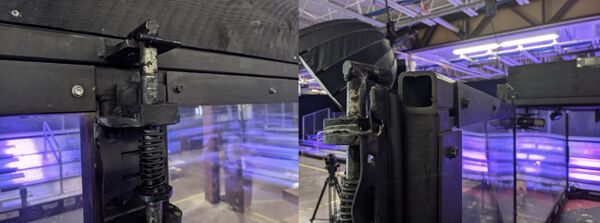
Floors
The floor of the cage is primarily composed of 2 sheets of ¾” plywood. The floor of the cage is not connected to the walls, to allow a gap for ventilation. The floor fully sits on 3 steel tubes that span the width of the cage. These steel tubes are held in on either side in a cradle that does not allow them to move down or to the side, but that can be lifted out when the floor is not present for easy maintenance and to get the internal lexan out. The wooden corners and wooden side skirt of the cage are connected to the floors, but the steel skirt beyond the wooden skirt is bolted to the frame. There is a less than ⅛” gap between the wooden skirt and the steel skirt. The wooden skirt is held to the floor with wood screws from the underside through the plywood, while each of the corners gets a large bolt through the top retained with a nut under the floor plywood. Pictured below is one of the corners (left), and one of the floor support tubes in its cradle (right).
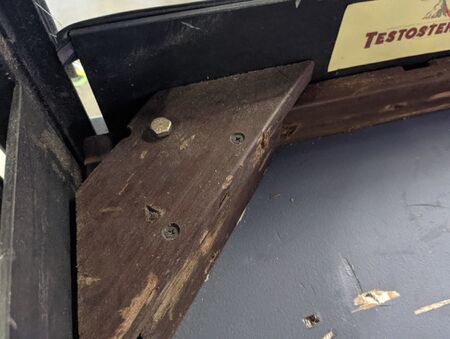 |
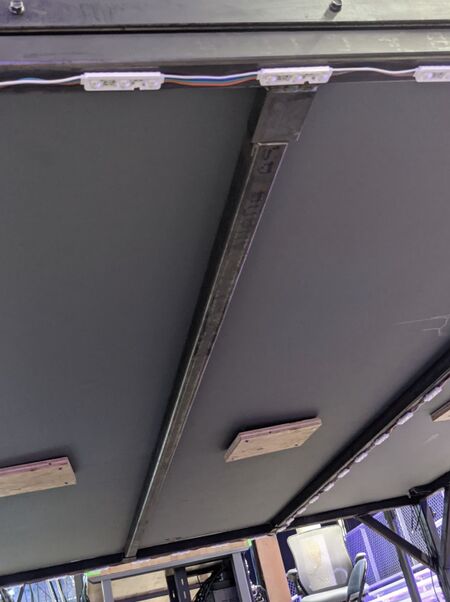 |
Ceiling
The ceiling is supported by a 2x4 frame that is bolted down into the top of the welded steel frame. Into this 2x4 frame, the ceiling (composed of 2 sheets of ¾” plywood) is secured with wood screws. The top of the ceiling also has some additional plywood pieces above the 2x4 frame to allow space for production equipment to be installed. Pictured below is the 2x4 frame resting on top of the steel frame.
